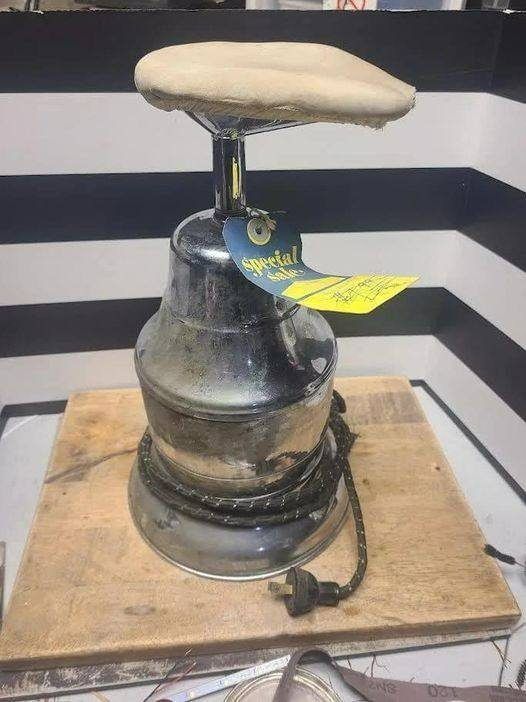Exploring abandoned places is always an adventure, offering a journey into the past that often raises more questions than answers. Recently, while wandering through an old, deserted farmhouse, I stumbled upon a peculiar item that immediately piqued my curiosity. Standing about 15 inches tall, with a steel chrome finish and a pear-shaped top covered in cloth, this object was unlike anything I had seen before. The base heats up when plugged in, adding to the mystery. The only clue to its identity was a single word etched into the metal: “WITT.”
The Initial Encounter
Abandoned buildings often hold remnants of the past, forgotten by time and left to gather dust. This farmhouse was no different, with its dilapidated structure and overgrown surroundings telling a silent story of neglect. As I navigated through the creaky wooden floors and cobweb-filled corners, my eyes caught a glint of metal among the debris. There, partially buried under a pile of old newspapers and broken furniture, was the mysterious object.
As I carefully unearthed it, the object’s weight and solid construction gave me the impression that it was built to last. It didn’t seem like the kind of thing you would find in a modern home, which only fueled my curiosity further. The room was dark, but the faint light from the cracked windows revealed its shiny surface. The object was unlike anything I had seen before, and it was clear that it had been long forgotten in this place, its history buried in time.
Physical Description
At first glance, the object appeared to be some sort of vintage home appliance. Its steel chrome finish was surprisingly well-preserved, reflecting the dim light filtering through the broken windows. The base was sturdy and designed to sit flat on a surface, with a cord extending from it, suggesting it was meant to be plugged into an electrical outlet. When I plugged it in, the base began to heat up gradually, confirming its functional nature. The top part of the device was particularly intriguing. Shaped like a pear and covered in cloth, it seemed to serve a specific purpose, though what that was, I couldn’t immediately determine. The cloth was slightly worn but still intact, suggesting it was designed to be durable. The pear shape gave it an aesthetic quality, hinting at a design that was both functional and pleasing to the eye.
The more I examined it, the more I realized that this was not just a random household item—it was a well-crafted object that likely had a very specific purpose. Yet, despite its intriguing features, it remained a mystery to me. What was this object? How had it ended up in an abandoned farmhouse? And why was it designed in such an unusual way?
Unraveling the Mystery of “WITT”
The most significant clue to the object’s identity was the word “WITT” engraved on its surface. It was a starting point for my investigation, but without context, it offered more questions than answers. Was it a brand name, an acronym, or perhaps the name of the inventor or owner? The mystery deepened as I tried to piece together the history and function of this enigmatic item.
At that moment, I realized that finding such an object in an abandoned farmhouse was like holding a piece of a forgotten puzzle. The word “WITT” could hold the key to unlocking the object’s true identity, but where to begin? After considering several possibilities, I decided to dive into some research.
Research and Hypotheses
Back home, I began my research in earnest. The first step was to look up “WITT” in various contexts. After sifting through numerous possibilities, I found that “WITT” could potentially refer to several things. It could be a brand, a designer’s name, or even an abbreviation for a company. I delved into historical archives, patent databases, and vintage appliance catalogues, hoping to find a match. Each source provided more potential leads, but none seemed to point directly to this object.
Given the object’s physical attributes, I began to hypothesize that it might be an electric heater, perhaps a vintage model designed for a very specific purpose. The heating base suggested that it could be an appliance used to warm something—possibly water, oil, or another liquid. The pear-shaped cloth cover made me wonder if it had something to do with diffusing air or moisture.
Possible Uses and Functions
As I continued to research, I considered various uses for the device. Given its design, the object seemed to be an electric heater of some sort. The heating base suggested it was meant to warm something, but what? The pear-shaped cloth-covered top provided a vital clue. I hypothesized that it might be a vintage humidifier or a device for diffusing scents. In the mid-20th century, such appliances were common in households, designed to improve indoor air quality and provide a pleasant aroma.
But what was the “WITT” connection? Could this be a long-lost model from a once-popular brand? Was there something significant about its design that set it apart from other humidifiers of the time? As I pieced together information from various sources, it became clear that this object had a rich history that was worth uncovering.
Discovering the True Purpose
After days of research and consultations with experts in vintage appliances, I found a breakthrough. The object was indeed a humidifier, manufactured by a company named WITT in the 1950s. The design was typical of the era, combining functionality with a stylish aesthetic that was meant to blend seamlessly into a home’s decor.
The steel chrome finish was not just for show; it provided durability and a sleek, modern look that was popular in mid-century designs. The heating element at the base would warm water placed inside the device, creating steam that would rise through the pear-shaped top. The cloth cover acted as a filter and diffuser, ensuring that the steam was evenly distributed into the air. This device was meant to combat the dry air that many households struggled with, especially during the colder months.
Historical Context and Significance
Humidifiers like this one were especially popular in the post-World War II era when there was a boom in home appliance innovation. People were increasingly concerned with indoor air quality, and manufacturers responded with a variety of products designed to improve the living environment. The WITT humidifier was a part of this trend, offering a practical solution for dry indoor air, which was a common problem in many homes, particularly during the winter months.
The mid-20th century saw a surge in the availability of electric appliances designed to enhance comfort and convenience in the home. From air purifiers to vacuum cleaners, the market was flooded with innovative products that made life easier for homeowners. The WITT humidifier, with its functional yet attractive design, was one such product.
The WITT Brand Legacy
The WITT brand, it turns out, was a notable player in the home appliance market during the mid-20th century. Known for their innovative designs and reliable products, WITT appliances were a staple in many households. The company prided itself on blending functionality with style, a philosophy clearly reflected in the design of their humidifier.
As I dug deeper into the history of the brand, I discovered that WITT had been a leader in the production of various household appliances, including fans, humidifiers, and air purifiers. Their products were well-regarded for their durability and elegant design, which made them popular among homeowners who sought to bring both style and practicality into their homes.
Reflecting on the Find
Discovering this WITT humidifier in an abandoned farmhouse was more than just finding an old appliance; it was uncovering a piece of history. It told the story of a time when household appliances were built to last, with a focus on both utility and aesthetic appeal. The humidifier itself, despite being hidden away for decades, stood as a testament to the quality and design principles of its time.
The find also made me reflect on the changing nature of household products. Today, many appliances are designed with efficiency and convenience in mind, often at the cost of longevity and craftsmanship. The WITT humidifier, by contrast, was built to stand the test of time. It represented a moment in history when products were made with care, attention to detail, and a commitment to both form and function.
The Importance of Preservation
Items like the WITT humidifier are important artifacts of our technological and cultural history. They provide insight into the daily lives of people in the past, reflecting their needs, desires, and the technological advancements of their time. Preserving such items, whether in museums or private collections, helps keep these stories alive.
The objects we discard today may be tomorrow’s treasures, and it’s important to recognize their value before they are lost to time. Preserving vintage appliances, like the WITT humidifier, offers a glimpse into the ingenuity and creativity of past generations. By appreciating these objects, we can better understand the evolution of technology and design, as well as the broader cultural shifts that have shaped our world.
Conclusion
The journey from finding a mysterious object in an abandoned farmhouse to uncovering its history and purpose was a fascinating adventure. The WITT humidifier, with its elegant design and practical function, is a reminder of the ingenuity and craftsmanship of the past. It also underscores the importance of curiosity and research in bringing forgotten pieces of history back to light.
Exploring abandoned places and uncovering their secrets can lead to remarkable discoveries. Each item, no matter how small or seemingly insignificant, has a story to tell. The WITT humidifier is just one example of the countless treasures waiting to be found, each offering a unique glimpse into our collective past.





